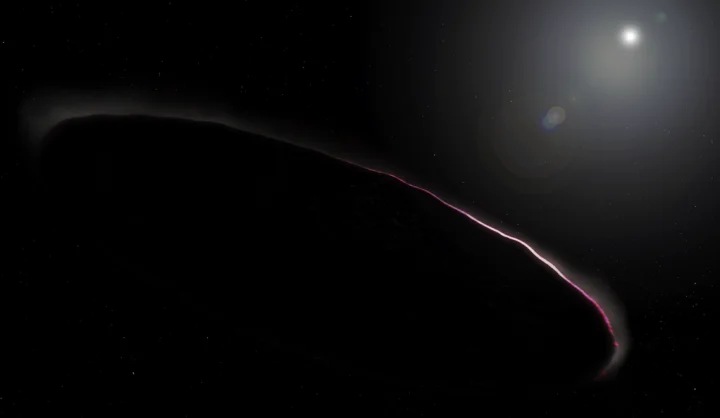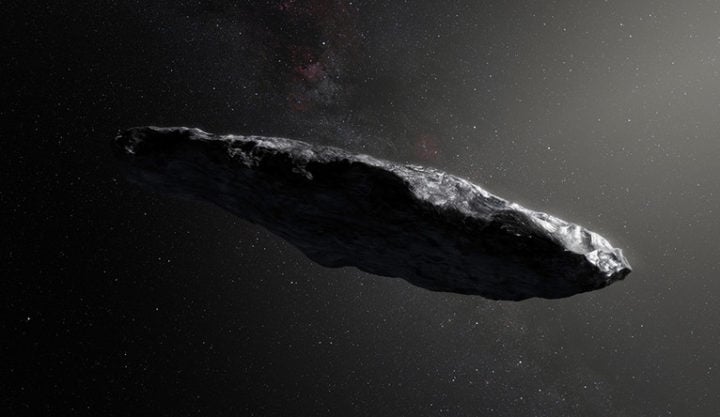A new study suggests that X-rays might be the key to understanding interstellar objects visiting our Solar system.
A research team led by a Yale astronomer has some advice for our next close encounter with a wandering interstellar object. Check its X-rays on the way out.

An interstellar object. Illustration by Samuel Cabot, Yale University
Since 2017, when a mysterious space rock known as ‘Oumuamua was spotted passing through Earth’s solar system, researchers have become increasingly aware of the likelihood that interstellar objects cross through the solar system with some regularity.
But there is no consensus about the makeup and origins of these objects.
Astronomers are particularly interested in whether the next interstellar objects speed up as they leave the solar system — as ‘Oumuamua did.
Here’s why: This same “anomalous acceleration” also occurs when an icy comet is heated by the sun. This has led some astronomers to suggest that ‘Oumuamua and other visiting space rocks are composed of an exotic ice.
But there’s a problem with that notion. If interstellar objects accelerate because they’re made of ice and then begin to melt when they are near the sun, there would be a trail of gas (such as water vapor or carbon dioxide) behind them. Yet state-of-the-art telescopes such as the Hubble Space Telescope and the Spitzer Space Telescope did not spot any gas surrounding ‘Oumuamua.

An artist’s impression of ‘Oumuamua. Image credit: ESO/M. Kornmesser
It’s a puzzle that has divided the scientific community into two general camps. Some say ‘Oumuamua was made of an exotic ice that is invisible in its gaseous form to most telescopes, while others suggest ‘Oumuamua was unusually lightweight, allowing it to be “pushed” ever-so-slightly by the miniscule pressure of sunlight.
Either way, there has never been a proven example of such an object in Earth’s solar system.
But a new study led by Samuel Cabot, who received his Ph.D. in astronomy at Yale earlier this year, offers a possible way to get some answers. Cabot and his collaborators say X-rays might be the key to understanding interstellar objects.
The study has been accepted by the Astrophysical Journal.
“X-ray telescopes will be paramount when an object like ‘Oumuamua comes our way again,” said Cabot, who will begin a postdoctoral position at the University of Cambridge in October.
“If we see X-rays, then a cloud of gas surrounds the object, and sublimation likely powers the anomalous acceleration. If we do not see X-rays, then other physics may be at play.”
The theory relies on the solar wind, which is responsible for the Aurora Borealis on Earth. The “wind” is a high-speed stream of ionized particles. When these ions reach a cool gas, they steal electrons, emitting X-rays and UV photons as those electrons cascade down in energy.
Crucially, this process happens with many types of gases, even ones that are invisible in the optical or infrared.
“Typically, X-rays provide diagnostics of the most extreme environments, like hot gas around black holes,” said Q. Daniel Wang, an X-ray astronomer and professor at University of Massachusetts, Amherst and co-author of the study. “But they can also be used to probe planets and potentially interstellar objects.”
Indeed, comets and planets such as Venus, Mars, and Jupiter emit X-rays — not directly, but rather because of the solar wind colliding with their atmospheres.
Cabot and his co-authors want to test their theory by observing new interstellar objects with the help of new instruments currently under construction.
“The forthcoming Rubin Observatory Legacy Survey of Space and Time (LSST) will give us an unprecedented increase in sensitivity to detecting these transient objects, offering us orders of magnitude increase in sensitivity and almost nightly coverage of the entire southern hemisphere,” said study co-author Darryl Seligman, a former Yale Ph.D. student who is a research fellow at Cornell University.
“We have estimated that the LSST is going to identify a handful of interstellar interlopers every year.”
Yale research has been crucial for understanding interstellar objects, including debunking artificial origin theories, showing ‘Oumuamua may have been a hydrogen iceberg, photographing an interstellar comet, and estimating the total number of interstellar objects in the galaxy.
“With X-ray observations, we might just solve the mystery of ‘Oumuamua-like interstellar objects, and in turn, reveal some new insights into how planets form,” Cabot said.
Source: Yale University

